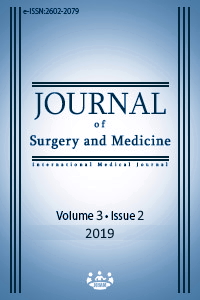Nosocomial Burkholderia cepacia infection in a tertiary hospital; Five-year surveillance: A retrospective cross-sectional study
Keywords:
Burkholderia cepacia, Surveillance, TurkeyAbstract
Aim: Burkholderia cepacia is an aerobic, Gram-negative and multi-drug resistance bacteria that cannot ferment glucose. Burkholderia cepacia, important opportunistic bacteria in immunosuppressed patients, causes severe pulmonary infections. In this study, we aimed to evaluate Burkholderia cepacia cases detected in last five years.
Methods: The study designed as retrospectively. Forty-six cases with B. cepacia in the tertiary hospital between 2013 and 2018 were included in the study. Age, gender, clinical history of the patient, type of sample taken, and patients’ final conditions (alive or dead) and duration of hospitalization were recorded.
Results: When the distribution of the samples were examined, it was found that 32.6% (n=15) in the blood culture, 32.6% (n=15) in the urine culture, 17.4% (n=8) in the tracheal aspirate culture and 17.4% (n=8). Patients’ final conditions were evaluated as alive or dead. Accordingly, 65.2% (n=30) were alive and 34.8% (n=16) of the patients were dead. When the distribution of the cases according to the clinics were examined, Anesthesia with 19.6% (n=9) was the first place. The average length of stay in hospital was 24.6 ± 25.3 days (minimum-maximum: 3-122 days).
Conclusion: Burkholderia cepacia is an important nosocomial opportunistic infection and is often multi drug resistant. For this reason, the disease should be effectively treated otherwise it should not be forgotten that the disease will result in mortality.
Downloads
References
Mahenthiralingam E, Baldwin A, Dowson CG. Burkholderia cepacia complex bacteria: Opportunistic pathogens with important natural biology. J Appl Microbiol. 2008;104:1539–51.
Yabuuchi E, Kosako Y, Oyaizu H, Yano I, Hotta H, Hashimoto Y, et. al. Proposal of Burkholderia gen. nov. and Transfer of Seven Species of the Genus Pseudomonas Homology Group II to the New Genus, with the Type Species Burkholderia cepacia (Palleroni and Holmes 1981) comb. nov. Microbiol Immunol. 1992;36:1251–75.
Serikawa T, Kobayashi S, Tamura T, Uchiyama M, Tsukada H, Takakuwa K, et. al. Pseudo outbreak of Burkholderia cepacia in vaginal cultures and intervention by hospital infection control team. J Hosp Infect. 2010;75:242–3.
Dizbay M, Tunccan OG, Sezer BE, Aktas F, Arman D. Nosocomial Burkholderia cepacia infections in a Turkish university hospital: a five-year surveillance. J Infect Dev Ctries. 2009;3(4):273-7.
LiPuma JJ. Burkholderia cepacia. Management issues and new insights. Clin Chest Med. 1998;19(3):473-86.
Saiman L, Siegel J. Cystic Fibrosis Foundation Consensus Conference on Infection Control Participants: Infection control recommendations for patients with cystic fibrosis: microbiology, important pathogens, and infection control practices to prevent patient-to-patient transmission, Am J Infect Control. 2003;31:1-62.
Maschmeyer G, Göbel UB. Stenotrophomonas maltophilia and Burkholderia cepacia complex. In Bennett JE, Mandell GL, Dolin R, editors. Principles and Practice of Infectious Diseases. Philadelphia: Churchill Livingstone; 2010. p. 2861-9.
Nasser RM, Rahi AC, Haddad MF, Daoud Z, Irani-Hakime N, Almawi WY. Outbreak of Burkholderia cepacia bacteremia traced to contaminated hospital water used for dilution of an alcohol skin antiseptic. Infect Control Hosp Epidemiol. 2004;25(3):231-9.
Abdelfattah R, Al-Jumaah S, Al-Qahtani A, Al-Thawadi S, Barron I, Al-Mofada S. Outbreak of Burkholderia cepacia bacteraemia in a tertiary care centre due to contaminated ultrasound probe gel. J Hosp Infect. 2018 Mar;98(3):289-94.
Koruk ST, Bayraktar M, Koruk İ, Yılmaz L. An Outbreak of Nosocomial Burkholderia cepacia Infection due to Contamination of Urinary Systoscope. ANKEM Derg. 2010;24(4):193-7.
Turan S, Ayık İ, Gömceli İ, Kazancı İ, Polat Y, Öztürk B, et. al. A Rare and Resistant Infection In ICU; Burkholderia Cepacia Case Report. Ankara Üniv Tıp Fak Mecm. 2010;63(4):123-6.
Sader HS, Jones RN. Antimicrobial susceptibility of uncommonly isolated non-enteric gram-negative bacilli. Int J Antimicrob Agents. 2005;25:95-109.
Manno G, Ugolotti E, Belli ML, Fenu ML, Romano L, Cruciani M. Use of the E test to assess synergy of antibiotic combinations against isolates of Burkholderia cepacia-complex from patients with cystic fibrosis. Eur J Clin Microbiol Infect Dis. 2003;22:28-34.
Araque-Calderon Y, Miranda-Contreras L, Rodriguez-Lemoine V, Palacios-Pru EL. Antibiotic resistance patterns and SDS-PAGE protein profiles of Burkholderia cepacia complex isolates from nosocomial and environmental sources in Venezuela. Med Sci Monit. 2008;14:49-55.
Bonacorsi S, Fitoussi F, Lhopital S, Bingen E. Comparative in vitro activities of meropenem, imipenem, temocillin, piperacillin, and ceftazidime in combination with tobramycin, rifampin, or ciprofloxacin against Burkholderia cepacia isolates from patients with cystic fibrosis. Antimicrob Agents Chemother. 1999;43:213-7.
Aydemir Ö, Terzi HA, Karakeçe E, Köroğlu M, Aydemir Y, Çavdar G, et al. Evaluation of Antibiotic Susceptibilities and Clinical Characteristics of Burkholderia Cepacia Isolates. Journal of BSHR. 2018;2(1):35-40.
Srinivasan S, Arora NC, Sahai K. Report on the newly emerging nosocomial Burkholderia cepacia in a tertiary hospital. Med J Armed Forces India. 2016;72(1):50-3.
Downloads
- 1658 1956
Published
Issue
Section
How to Cite
License
Copyright (c) 2019 Selçuk Nazik, Bircan Topal, Ahmet Rıza Şahin, Selma Ateş
This work is licensed under a Creative Commons Attribution-NonCommercial-NoDerivatives 4.0 International License.
















